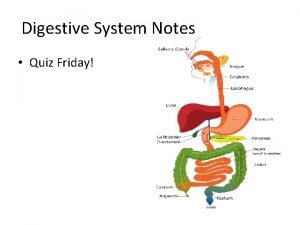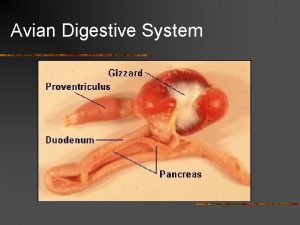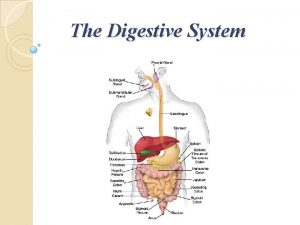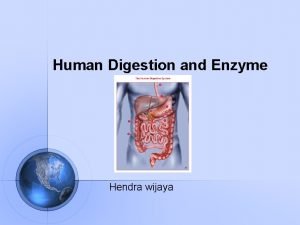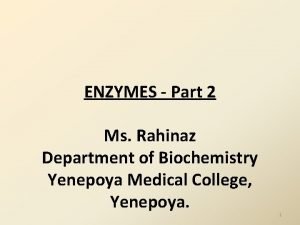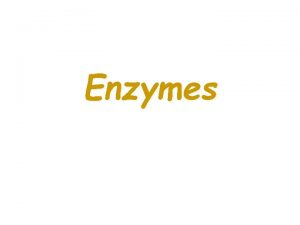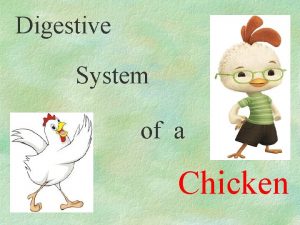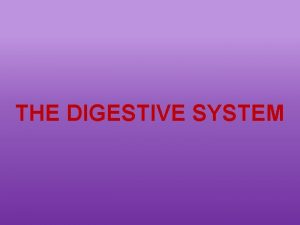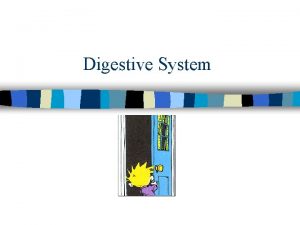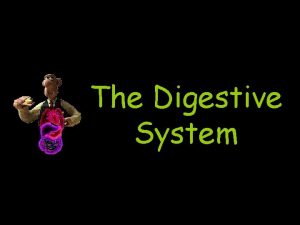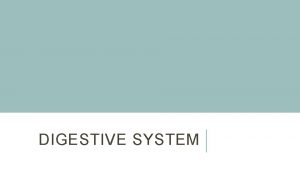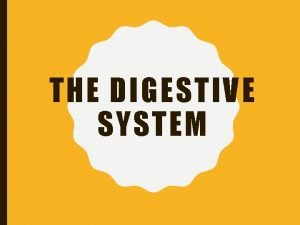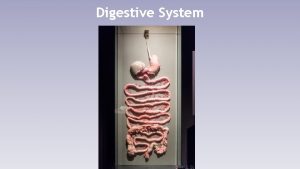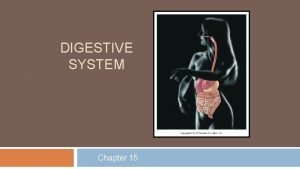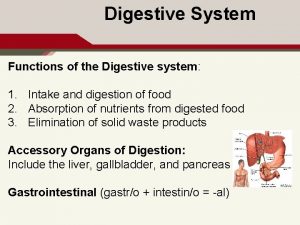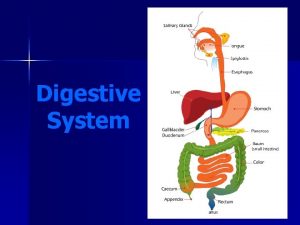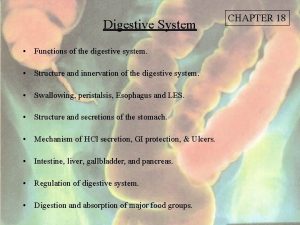Digestive System Functions of the Digestive System 1































- Slides: 31

Digestive System

Functions of the Digestive System 1) Ingestion: voluntary process of placing the food in the mouth. � 2) Propulsion: food being moved from one organ to the next by peristalsis (involuntary alternating rings of muscle contraction to squeeze food through a tube ex: swallowing) � 3) Mechanical Food Digestion: chewing and segmentation are examples of physical processes that break food apart. Segmentation is a process that moves the food within an organ in order to mix it with digestive juices. �

Functions of the Digestive System 4) Chemical Food Digestion: sequence of steps that uses enzymes to break down macromolecules into their building blocks. � 5) Absorption: transportation of nutrients from the digestive tract into the blood stream and lymph to be circulated and used throughout the body. � 6) Defecation: elimination of indigestible materials. �

Nutrition Some food that is digested and nutrients that are absorbed by the body are used to create new cell structures or replace worn out cells but most are used as metabolic fuels to create ATP. � A kilocalorie (C) is a measure of the energy value of food. �

Nutrition Nutrients are substances in food that are used by the body for normal growth, maintenance, and repair. � The six major nutrient categories include carbohydrates, lipids, and proteins which make up the bulk of what we eat, vitamins and minerals which are needed in minute amounts, and water which makes up about 60% of the food we eat. �

Nutrition � Carbohydrates: › Sugars and starches are derived from plants with the exceptions being milk sugar (lactose) and glycogen in meat. › Sugars come from fruits, sugar cane, and milk. Polysaccharide starches are in grains, legumes, and root vegetables. › Polysaccharide cellulose is found in most vegetables but the body cannot digest it. Instead this is used to add roughage (fiber) and to increase the bulk of feces to aid in defecation.

Nutrition � Lipids: › Most lipids that are ingested are neutral fats called triglycerides. › Saturated fats are taken in from animal products such as meat and dairy and a few plants such as coconut. › Unsaturated fats are present in seeds, nuts, and most vegetable oils. › Cholesterol is found in egg yolk, meats, and milk products.

Nutrition � Proteins: › Animal products contain the highest quality proteins that because they contain all of the essential amino acids needed by humans for tissue repair and growth. This is called a complete protein. › Plant products such as beans, peas, nuts, and cereals are also protein rich but they are incomplete proteins because they are missing at least one of the essential amino acids.

Nutrition � Carbohydrates are usually broken down to make ATP. Fats are broken down and used to build membranes, insulate and cushion vital body organs, and to create the myelin sheath of nerve cells. They also serve as the main source of energy for making ATP when carbs are inadequate. Proteins are hoarded by the body and used to create cell structures and enzymes.

Nutrition Vitamins: Organic nutrients that are required by the body in small amounts. Most work as coenzymes or molecules that help enzymes perform their task. � Minerals: inorganic substances including calcium, phosphorus, potassium, sulfur, sodium, chloride, and magnesium. Fats and sugars have almost no minerals, cereals and grains have very little, and the best sources are vegetables, legumes, and meats. �

Metabolism � Metabolism refers to all of the chemical reactions that take place in the body including catabolism or the breaking down of large substances and anabolism or the building of complex structures.

Carbohydrate Metabolism � The main process used to break down carbs is cell respiration. In this process glucose (blood sugar) is broken apart into CO 2 releasing high energy electrons and hydrogen ions. The energy from the electrons and H+ ions is used to attach ADP and a third phosphate creating ATP. The electrons and hydrogen are then attached to an oxygen molecule to make water. This process occurs in the mitochondria and produces 36 ATP for each glucose molecule.

Carbohydrate Metabolism � Because glucose is the major source of energy for the cell maintaining a homeostatic balance in the blood is essential. If there is too much (hyperglycemia) the glucose is converted to glycogen and stored in liver and muscle cells. If the problem continues then the excess sugar is converted to fat and stored. If the glucose level gets too low then the liver breaks down the stored glycogen for cell use.

Fat Metabolism The liver breaks down fat for ATP synthesis and to make lipoproteins, cholesterol, and thromboplastin (a clotting protein). It then releases the rest into the blood for body cells to remove fat pieces and cholesterol to create membranes and steroid hormones. � To be broken down to make ATP fat is converted to acetic acid and then broken down to release CO 2 in the mitochondria the same as glucose. �

Fat Metabolism � When there are insufficient carbs the breakdown of fat is accelerated but incomplete. The substances that are left accumulate in the blood making it acidic and giving the breath a fruity odor. This is common in uncontrolled diabetes and starvation.

Protein Metabolism � Proteins are broken into amino acids during digestion and taken to the liver. Once the liver has had enough the amino acids are transported to the other cells by the blood stream. The cells use these to build proteins such as enzymes, membranes proteins, mitotic spindle fibers, muscle proteins, mucus, and hormones. The cells hoard amino acids for future use because they are incapable of making proteins without all 20 amino acids.

The Liver in Metabolism � The liver : › manufactures bile for fat emulsification in the small intestine › detoxifies drugs and alcohol › degrades hormones › removes ammonia and converts it to urea › makes cholesterol for the construction of hormones and plasma membranes › processes nearly every nutrient absorbed by the digestive system

The Liver in Metabolism › Maintains glucose levels: the liver removes excess glucose from the blood and constructs glycogen to store it in a process called glycogenesis. Liver cells will break down this glycogen in times of need in a process called glycogenolysis to put glucose into the blood. They can also create glucose from fats or proteins in a process called gluconeogenesis if necessary.

The Liver in Metabolism › Makes blood proteins such as albumin (holds fluid in the blood to prevent edema), clotting proteins, and lipoproteins which help transport water insoluble substances such as fats and cholesterol through the blood stream � The hypatic portal circulation brings nutrient rich blood from the digestive system directly to the liver. This ensures the livers needs are met first.

Organs of the Digestive System The alimentary tract also known as the gastrointestinal (GI) tract is a continuous hallow tube that is open at both ends. This includes the mouth, pharynx, esophagus, stomach, small intestine and large intestine. � Accessory organs are used to aid in digestion but are not part of the path of food such as glands, teeth, the pancreas, gallbladder and liver. �

Mouth Lingual frenulum: attaches tongue limiting posterior movement. � Teeth tear and grind food. The deciduous/baby/milk teeth emerge between 6 months and 2 yrs. As perminant teeth develop the root of the baby tooth is reabsorbed so the tooth loosens and falls out. Food enters the mouth, is mechanically broken down by the tongue and teeth, chemically broken down by amylase (starch maltose) and voluntarily swallowed. �

Pharynx: peristalsis begins here. The alternating contractions of the two layers of muscle push food through the pharynx to the esophagus involuntarily. This process is controlled by the parasympathetic nervous system. � Esophagus: involuntary peristalsis continues to push food down to the stomach. Because of the constant abrasion the esophagus is lined with stratified squamous cells while the rest of the GI tract has simple cuboidal or columnar. � Glands: produces saliva which contains mucus and serous fluid. Serous fluid contains salivary amylase that starts to digest starch. This mix helps moisten and bind food together into bolus to be swallowed, the lysozyme and antibodies inhibit bacteria and dissolves food chemicals to allow taste. �

Teeth � � � Crown: covered in enamel which is made with calcium salts to be very hard. Dentin: bone like bulk of tooth. Pulp cavity: contains pulp that has blood vessels, connective tissue and nerves that supply the tooth with nutrients and sensation. Cementum: attaches root to the periodontal membrane. Periodontal membrane: ligaments that hold tooth in the jaw bone Root canal: creates path for blood vessels and nerves to pulp cavity

Layers of GI Tract Mucosa: inner most lining that is moist and includes epithelium, connective tissue and smooth muscle, can be folded to increase surface area for ansorption � Submucosa: second layer that contains blood vessels to provide nutrients, nerve endings, lymph nodules, and vessels. � Muscularis externa: two layers of muscle one circular and one longitudinal that alternate contraction to create a wave of motion � Serosa: outer most layer that may be modified into a membrane that is used to anchor the organ in place �

Stomach � � � Cardioesophageal sphincter: opening through which food enters the stomach from the esophagus Layers of muscularis externa that move the food through the stomach and churn in the mix it with digestive juices to break down Rugau: folds of mucosa that appear when the stomach is empty Pylorus: peristalsis of this portion pushes chyme through the sphincter Pyloric sphincter: opens slightly to allow small amounts of chyme through. Takes 4 -6 hrs to empty stomach contents. About 25 cm long and able to expand to hold 4 liters the stomach acts as a storage tank, site of chemical protein digestion, and site of mechanical digestion. After the stomach processes food it resembles heavy cream and is called chyme. Production of gastic juices is regulated by the parasympathetic nervous system that is stimulated by the sight, smell, and taste of food and by hormone gastrin that is produced when food enters the stomach changing the p. H. This hormone encourages the glands to produce more gastric juices. Normally the stomach produces 2 -3 liters a day. The stomach does not absorb nutrients other than things like alcohol and aspirin.

Glands of the Stomach � � � Gastic gland: produces gastric juices to begin chemical digestion of food Chief cells: produces protein digesting enzymes like pepsinogen Gastric gland duct: transport juices to the surface Parietal cells: produces hydrochloric acid (HCl) which raises the acidity of the stomach activating enzymes like pepsin Mucous neck cells: produce a sticky alkaline substance that coats the stomach lining to protect it from the HCl and digestion enzymes like pepsin Simple columnar epithelium: produces mucus

Pancreas � Creates enzymes that complete macromolecule breakdown once in the duodenum. Amylase finishes the break down of sugars that started in the mouth. Trypsin, chymotrypsin, and carboxypeptidase carry out half of the protein digestion. Lipase completely breaks down lipids and nuclease breaks down nucleic acids. Bicarbonates produced here help to neutralize the chyme from the stomach and activate the enzymes.

Liver � Made of four lobes the liver makes bile. Bile works like a detergent to emulsify (break apart) large fat globules into smaller fat globules providing more surface area for enzymes to work on. Also helps absorb fat and fat soluble vitamins like K, D, and A once in the small intestine. � Gallbladder: stores and concentrates bile

duodenum � Produces “brush border” enzymes that help break down sugars. Also produces the hormones secretin which travels through the to stimulate the pancreas and liver to increase output and the enzyme cholecystokinin (CCK) that prompts the gallbladder and pancreas to release stored substances.

Small Intestine

Large Intestine
 Digestive system 4 main functions
Digestive system 4 main functions Mouth function in digestion
Mouth function in digestion Bird digestive system functions
Bird digestive system functions Digestive system of ruminant
Digestive system of ruminant H pylori symptoms
H pylori symptoms Circularory system
Circularory system Intestinal enzymes
Intestinal enzymes Suicide inhibitor
Suicide inhibitor List of enzymes and their functions
List of enzymes and their functions Hình ảnh bộ gõ cơ thể búng tay
Hình ảnh bộ gõ cơ thể búng tay Slidetodoc
Slidetodoc Bổ thể
Bổ thể Tỉ lệ cơ thể trẻ em
Tỉ lệ cơ thể trẻ em Gấu đi như thế nào
Gấu đi như thế nào Glasgow thang điểm
Glasgow thang điểm Chúa yêu trần thế
Chúa yêu trần thế Kể tên các môn thể thao
Kể tên các môn thể thao Thế nào là hệ số cao nhất
Thế nào là hệ số cao nhất Các châu lục và đại dương trên thế giới
Các châu lục và đại dương trên thế giới Công của trọng lực
Công của trọng lực Trời xanh đây là của chúng ta thể thơ
Trời xanh đây là của chúng ta thể thơ Mật thư tọa độ 5x5
Mật thư tọa độ 5x5 101012 bằng
101012 bằng độ dài liên kết
độ dài liên kết Các châu lục và đại dương trên thế giới
Các châu lục và đại dương trên thế giới Thơ thất ngôn tứ tuyệt đường luật
Thơ thất ngôn tứ tuyệt đường luật Quá trình desamine hóa có thể tạo ra
Quá trình desamine hóa có thể tạo ra Một số thể thơ truyền thống
Một số thể thơ truyền thống Bàn tay mà dây bẩn
Bàn tay mà dây bẩn Vẽ hình chiếu vuông góc của vật thể sau
Vẽ hình chiếu vuông góc của vật thể sau Nguyên nhân của sự mỏi cơ sinh 8
Nguyên nhân của sự mỏi cơ sinh 8 đặc điểm cơ thể của người tối cổ
đặc điểm cơ thể của người tối cổ
